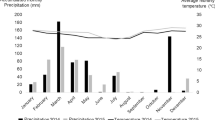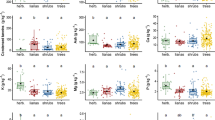Abstract
Leaf-hay was the principal winter feed of livestock from the Neolithic until the first archaeological records of scythes dated to the Iron Age (700–0 b.c.). Despite the use of meadow hay, leaf-fodder remained an important winter supplement until the present. Archaeological evidence lists Quercus, Tilia, Ulmus, Acer, Fraxinus and Corylus as woody species harvested for leaf-fodder, while Fagus, Populus or Carpinus were rarely used. The aim of our study was to test whether the use of listed woody species followed the pattern of their forage quality (syn. nutritive value). In late May 2012, we collected leaf biomass at four localities in the Czech Republic and determined concentrations of N, P, K, Ca, Mg, neutral- and acid-detergent fibre and lignin. Species with leaves of low forage quality were Carpinus betulus, Fagus sylvatica and Quercus robur, species with leaves of intermediate quality were Corylus avellana and Populus tremula and species with leaves of high quality were Ulmus glabra, Fraxinus excelsior, Tilia cordata and Acer platanoides. Selective browsing and harvesting of high quality species Acer, Fraxinus, Tilia and Ulmus thus probably supported their decline in the Bronze and Iron ages and supported the expansion of Carpinus and Fagus. Our results indicate that our ancestors’ practice of exploiting woody species as leaf-hay for winter fodder followed their nutritive value.

Similar content being viewed by others
References
Akeret Ö, Jacomet S (1997) Analysis of plant macrofossils in goat/sheep faeces from the Neolithic lake shore settlement of Horgen Scheller-an indication of prehistoric transhumance? Veget Hist Archaeobot 6:235–239
Akeret Ö, Rentzel P (2001) Micromorphology and plant macrofossil analysis of cattle dung from the Neolithic lake shore settlement of Arbon Bleiche 3. Geoarchaeol 16:687–700
Akeret Ö, Hass JN, Leuzinger U, Jacomet S (1999) Plant macrofossils and pollen in goat/sheep faeces from the Neolithic lake-shore settlement Arbon Bleiche 3, Switzerland. Holocene 9:175–182
AOAC (1984) Official methods of analysis. Association of Official Agricultural Chemists, Washington
Ash HB (1941) tr. Lucius Junius Moderatus Columella: On agriculture I. Harvard University Press, Cambridge
Austad I (1988) Tree pollarding in Western Norway. In: Birks HH, Birks HJ, Kaland PE, Moe D (eds) The cultural landscape, past, present and future. Cambridge University Press, Cambridge, pp 13–29
Austad I, Hauge L (2006) Pollarding in western Norway. 1er Colloque Europeen sur les trognes, 26–28 Oct, Vendome, France
Balasse M, Boury L, Ughetto-Monfrin J, Tresset A (2012) Stable isotope insights (δ 18 O, δ 13 C) into cattle and sheep husbandry at Bercy (Paris, France, 4th millennium b.c.): birth seasonality and winter leaf foddering. Envir Archaeol 17:29–44
Butler EJ (1963) The mineral element content of spring pasture in relation to the occurrence of grass tetany and hypomagnesaemia in dairy cows. J Agric Sci 60:329–340
Cheema UB, Younas M, Sultan JI, Virk MR, Tariq M, Waheed A (2011) Fodder tree leaves: an alternative source of livestock feeding. Adv Agr Bio 2:22–33
Chytrý M (2012) Vegetation of the Czech Republic: diversity, ecology, history and dynamics. Preslia 84:427–504
Delhon C, Martin L, Argant J, Thiébault S (2008) Shepherds and plants in the Alps: multi-proxy archaeobotanical analysis of neolithic dung from “La Grande Rivoire” (Isère, France). J Archaeol Sci 35:2,937–2,952
Dreslerová D (2012) Forest in the prehistoric landscape II. Archeologické rozhledy 64:199–236
Haas JN, Karg S, Rasmussen P (1998) Beech leaves and twigs used as a winter fodder: examples from historic and prehistoric times. Envir Archaeol 1:81–86
Halstead P (1998) Ask the fellows who lop the hay: leaf-fodder in the mountains of Northwest Greece. Rural Hist 9:21–234
Hejcman M, Pavlů V, Hejcmanová P, Gaisler J, Hakl J, Rauch O (2006) Farmer decision making and its effect on the subalpine grassland succession in the Giant Mountains, Czech Republic. Acta Soc Bot Pol 75:165–174
Hejcman M, Szaková J, Schellberg J, Tlustoš P (2010) The Rengen Grassland experiment: relationship between soil and biomass chemical properties, amount of elements applied, and their uptake. Plant Soil 333:163–179
Hejcman M, Strnad L, Hejcmanová P, Pavlů V (2012) Response of plant species composition, biomass production and biomass chemical properties to high N, P and K application rates in Dactylis glomerata- and Festuca arundinacea-dominated grassland. Grass Forage Sci 67:488–506
Hejcman M, Hejcmanová P, Pavlů V, Beneš J (2013) Origin and history of grasslands in Central Europe—a review. Grass Forage Sci 68:345–363
Hooper WD, Ash HB (1935) Marcus Porcius Cato, on agriculture: Marcus Terentius Varro, on agriculture. Harvard University Press, London
Howe JC, Barry TN, Popay AJ (1988) Voluntary intake and digestion of gorse (Ulex europeus) by goats and sheep. J Agric Sci 11:107–114
Hrevušová Z, Hejcman M, Pavlů VV, Hakl J, Klaudisová M, Mrkvička J (2009) Long-term dynamics of biomass production, soil chemical properties and plant species composition of alluvial grassland after the cessation of fertilizer application in the Czech Republic. Agr Ecosyst Envir 130:123–130
Isselstein J, Griffith BA, Pradel P, Venerus S (2007) Effects of livestock breed and grazing intensity on biodiversity and production in grazing systems. 1. Nutritive value of herbage and livestock performance. Grass Forage Sci 62:145–158
Iversen J (1973) The development of Denmark’s nature since the last glacial. Dan Geol Unders, Series V, 7-C:1–126
Karg S (1998) Winter- and spring-foddering of sheep/goat in the bronze age site of Fiave-Carera, Northern Italy. Envir Archaeol 1:87–94
Kayser M, Isselstein J (2005) Potassium cycling and losses in grassland systems: a review. Grass Forage Sci 60:213–224
Kelly F (2000) Early farming: a study based mainly on the law-texts of the 7th and 8th centuries A.D. School of Celtic Studies, Dublin
Kobe KE, Lepczyk CA, Iyer M (2005) Resorption efficiency decreases with increasing green leaf nutrients in a global data set. Ecol 86:2,780–2,792
Kudrna V (ed) (1998) Feed production and cattle nutrition (In Czech: Produkce krmiv a výživa skotu). Agrospoj, Praha
Kyselý R (2012) The palaeoeconomy of the Bohemian and Moravian Lengyel and Eneolithic periods from the perspective of archaeozoology. Památky Archeologické CIII:5–70
Le Houerou HN (2000) Utilization of fodder trees and shrubs in the arid and semiarid zones of West Asia and North Africa. Arid Soil Res Rehab 14:101–135
Liebisch F, Bünemann EK, Huguenin-Elie O, Jeangros B, Frossard E, Oberson A (2013) Plant phosphorus nutrition indicators evaluated in agricultural grasslands managed at different intensities. Eur J Agron 44:67–77
Magyari EK, Chapman J, Fairbairn AS, Francis M, De Guzman M (2012) Neolithic human impact on the landscapes of North-East Hungary inferred from pollen and settlement records. Veget Hist Archaeobot 21:279–302
Martin L (2011) Une bergerie néolithique dans le Vercors: analyse des macro-restes végétaux des “fumiers” fossiles de la Grande Rivoire (Isère, France). In: Wiethold J (ed) Carpologia : Articles réunis à la mémoire de Karen Lundström-Baudais. Actes de la table ronde de carpologues françaises, tenu à Bibracte, Centre archéologique européen, Glux-en-Glenne, 9–12 juin 2005. BIBRACTE 20. CAE europeen Mont-Beuvray, pp 27–38
Martin L, Delhon C, Argant J, Thiebault S (2011) Un aperçu de l’élevage au Néolithique par l’archéobotanique. L’exemple d’une bergerie dans le nord du Vercors. In: Lefèvre C, Denis B (eds) Le mouton, de la domestication à l’élevage. Actes de la journée scientifique organisée par l’association L’Homme et l’Animal, société de recherche interdisciplinaire (HASRI) et la Société d’Ethnozootechnie. Ethnozootechnie 91:37–45
Musonda K, Barry TN, McWilliam EL, Lopez-Villalobos N, Pomroy WE (2009) Grazing willow (Salix spp.) fodder blocks for increased reproductive rates and internal parasite control in mated hoggets. Anim Feed Sci Tech 150:46–61
Papachristou TG (1997) Intake, digestibility and nutrient utilization of oriental hornbeam and manna ash browse by goats and sheep. Small Rumin Res 23:91–98
Papachristou TG, Nastis AS (1993) Diets of goats grazing oak shrublands of varying cover in northern Greece. J Range Manage 46:220–226
Papachristou TG, Dziba LE, Provenza FD (2005) Foraging ecology of goats and sheep on wooded rangelands. Small Rumin Res 59:141–156
Pavlů V, Hejcman M, Pavlů L, Gaisler J, Nežerková P (2006) Effect of continuous grazing on forage quality, quantity and animal performance. Agric Ecosyst Envir 113:349–355
Pokorný P, Kuneš P (2005) Holocene acidification process recorded in three pollen profiles from Czech sandstone and river terrace environments. Ferrantia 44:101–107
Poschlod P, WallisDeVries MF (2002) The historical and socioeconomic perspective of calcareous grasslands—lessons from the distant and recent past. Biol Conserv 104:361–376
Rasmussen P (1989) Leaf-foddering of livestock in the Neolithic. Archaeobotanical evidence from Weier, Switzerland. J Dan Archeol 8:51–71
Rasmussen P (1993) Analysis of goat/sheep faces from Egolzwil-3, Switzerland: evidence for branch and twig foddering of livestock in the Neolithic. J Archaeol Sci 20:479–502
Regnell M (2003). Charcoals from Uppåkra as indicators of leaf fodder. Centrality—Regionality 105–115
Roothaert RL, Paterson RT (1997) Recent work on the production and utilization of tree fodder in East Africa. Anim Feed Sci Tech 69:39–51
Schibler J, Chaix L (1995) Wirtschaftliche Entwicklung aufgrund archäozoologischer Daten. In: Stöckli WE, Niffeler U, Gross-Klee E (eds) SPM II: Neolithikum—Néolitique—Neolitico. Schweizerische Gesellschaft für Ur- und Frühgeschichte, Basel, pp 97–118
Shahack-Gross R (2011) Herbivorous livestock dung: formation, taphonomy, methods for identification, and archaeological significance. J Archaeol Sci 38:205–218
Slotte H (2001) Harvesting the leaf-hay shaped the Swedish landscape. Landscape Ecol 16:691–702
Smith J (2010) The history of temperate agroforestry. The Organic Research Centre. Elm Farm, Hamstead Marshall, p 17
Swerczek TW (2007) Nitrate toxicity and sodium deficiency associated with hypomagnesemia, hypocalcemia and grass tetany syndrome in herbivores. Annual Growers Nutritional Mineral Meeting, Milan
Tallowin JRB, Jefferson RG (1999) Hay production from lowland semi-natural grasslands: a review of implications for ruminant livestock systems. Grass Forage Sci 54:99–115
Ter Braak CJF, Šmilauer P (2002) CANOCO Reference Manual and CanoDraw for Windows User’s Guide: Software for Canonical Community Ordination (version 4.5). Ithaca (www.canoco.com): Microcomputer power
Troels-Smith J (1960) Ivy, mistletoe and elm: climatic indicators, fodder plants. Dan Geol Unders Series 4:1–32
Whitehead DC (1995) Grassland Nitrogen. CAB International, Wallingford
Worrell MA, Clanton DC, Stroup WW, Nichols JT (1986) Effect of harvest date on meadow hay quality. I. Nutritional attributes, voluntary intake and rate of passage in growing cattle. J Anim Sci 63:1,527–1,537
Acknowledgments
The study was funded by a Grant from the Czech University of Life Sciences Prague CIGA 20114205.
Author information
Authors and Affiliations
Corresponding author
Additional information
Communicated by K.-E. Behre.
Rights and permissions
About this article
Cite this article
Hejcmanová, P., Stejskalová, M. & Hejcman, M. Forage quality of leaf-fodder from the main broad-leaved woody species and its possible consequences for the Holocene development of forest vegetation in Central Europe. Veget Hist Archaeobot 23, 607–613 (2014). https://doi.org/10.1007/s00334-013-0414-2
Received:
Accepted:
Published:
Issue Date:
DOI: https://doi.org/10.1007/s00334-013-0414-2




